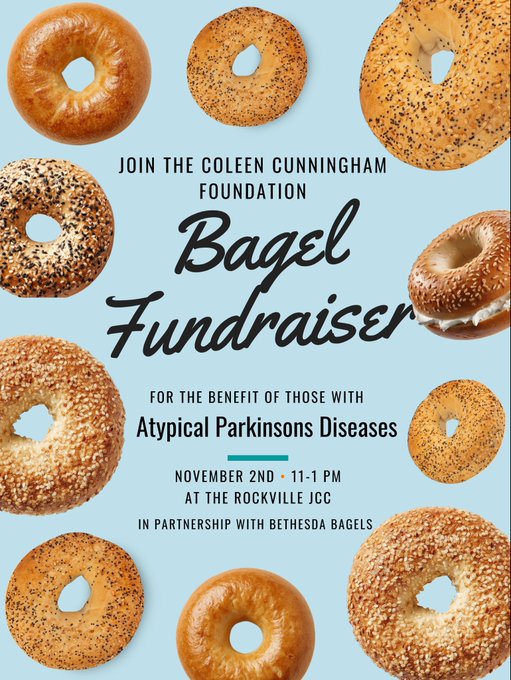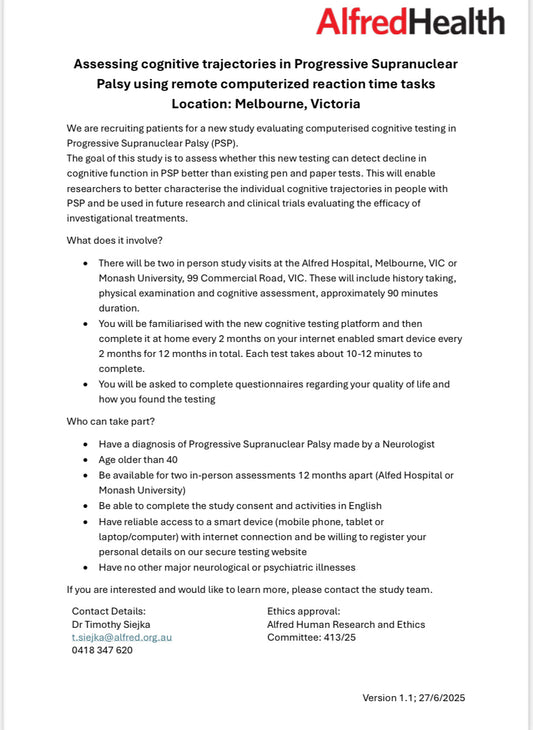It has been said there are four stages, but because there is so little research they are a guideline only.
Many people experience some stage four symptoms at stage one or overlap stages. Some never experience certain symptoms and then others can experience ones not listed. The impact it has on each individual varies dramatically.
Progressive Supranuclear Palsy (PSP) is a rare neurodegenerative disorder that affects movement, balance, vision, speech, and cognitive function. The disease progresses slowly over time, and its symptoms typically become more severe as the disease advances. While not everyone with PSP experiences the same symptoms or progression, there are generally four recognized stages of PSP:
-
Early stage: In the early stage of PSP, individuals may experience symptoms such as difficulty with balance and coordination, changes in gait, and problems with eye movement. These symptoms may be subtle and easily dismissed as normal aging or a different condition.
-
Mid-stage: In the mid-stage of PSP, symptoms become more pronounced and can include falls, speech and swallowing difficulties, and cognitive impairment such as problems with memory and executive function. Depression and apathy are also common.
-
Advanced stage: In the advanced stage of PSP, individuals may become wheelchair-bound and require assistance with daily activities such as eating, dressing, and bathing. Symptoms such as rigidity, spasticity, and involuntary movements become more severe.
-
End-of-life stage: In the end-of-life stage of PSP, individuals may be bedridden and require around-the-clock care. They may have difficulty swallowing, become more susceptible to infections, and experience other complications related to the progression of the disease.
It's important to note that not everyone with PSP will experience all of these stages, and the progression of the disease can vary widely from person to person. Additionally, some individuals may experience rapid progression, while others may experience a slower course of the disease.
Here is the four stages below in more detail;
Early stage:
May present via the fracture clinic, falls services, eye specialist or speech and language therapist. The early stage typically spans years 0-1.
> Ambulant.
> Occasional falls.
> Unsteadiness and poor balance.
> Possible visual problems affecting ability to read.
> Voice changes, for example reduced volume.
> Mood changes.
> Reduced socializing.
> Changes in mood and behavior, including apathy and anxiety.
Mid stage:
Many people reach this stage before diagnosis. Consider discussing advance care planning and advance decisions to refuse treatment. Consider referral to palliative care services. The mid stage typically spans years 2-3.
> Ambulant with aids.
> High risk of falls and injury.
> Visual problems affecting self-care abilities, for example eating and walking as unable to move eyes to see.
> Speech increasingly unintelligible.
> Inability to initiate conversation.
> Impulsivity (risky or impulsive behavior).
> Apathy.
> Dysphagia.
> High level of supervision required.
> Increasingly socially withdrawn.
Advanced stage:
Patients should be on GP palliative care register and have access to specialist palliative care.
The advanced stage typically spans years 3-6.
> Mobility significantly compromised, probably chair bound requiring a wheelchair for mobility.
> Significant visual problems.
> Significant muscle stiffness.
> Significant communication problems, but probably still able to understand.
> High risk of aspiration and pneumonia as a result of dysphagia.
> Pain.
> Increasing periods of sleepiness.
> Incontinence.
> Severely withdrawn socially.
> Dependent for most or all aspects of care.
End of life stage:
This stage is difficult to detect, but may be indicated by reduced levels of consciousness, inability to eat or drink, acute infection, a fall or major fracture, and rapid and significant weight loss. The end of life stage typically spans 6-8 weeks.
> Severe impairments and disabilities.
> Rapid and marked deterioration in condition.
> Decisions with regard to treatment interventions may be required, considering an individual’s previously expressed wishes (advance decisions to refuse treatment).
Discover the Benefits of Vielight Red Light Therapy for Atypical Parkinsonism


 Donate
Donate




131 comments
Is there a group for psp sufferers
Hi David,
I’m sorry to hear about your ongoing health struggles. It sounds like you’re experiencing a complex array of symptoms, and it’s understandable that you’re seeking clarity on your condition. I’ll try to provide some guidance, but please remember that only a healthcare professional can offer medical advice or diagnoses.
1. Second Opinion: Given your symptoms and concerns about your diagnosis, seeking a second opinion is a reasonable step. It would be beneficial to consult a neurologist who specializes in movement disorders, as they can provide a comprehensive evaluation. In Las Vegas, facilities like the Cleveland Clinic Lou Ruvo Center for Brain Health or other specialized neurology centers could be considered for an expert opinion.
2. Diagnostic Clarifications: Parkinson’s disease, Progressive Supranuclear Palsy (PSP), and Multiple Sclerosis (MS) can have overlapping symptoms but are distinct conditions requiring different approaches to management and treatment. Detailed neurological examinations, imaging studies (like MRI), and sometimes specific tests like lumbar puncture (spinal tap) are used to differentiate these conditions.
- A spinal tap can help in diagnosing conditions like MS by analyzing the cerebrospinal fluid for specific markers of inflammation and immune activity typical of MS. However, it’s not directly used for diagnosing Parkinson’s or PSP. Your doctor can determine whether this procedure is necessary for you.
3. Symptom Management: Regardless of your diagnosis, symptom management is crucial. For issues like mood swings, slurred speech, balance problems, and numbness, various therapies might help. These can include physical therapy, speech therapy, or medication adjustments. Regular follow-ups with your healthcare team to monitor and adjust your treatment plan are essential, especially if your current regimen doesn’t seem to be helping.
4. Support Groups: Connecting with others who are going through similar experiences can be immensely helpful. Look for support groups in the Las Vegas area for individuals with neurological conditions. These communities can often provide not just emotional support but also practical advice and resources.
Remember, online or over-the-phone advice cannot replace a thorough clinical evaluation. It’s essential to communicate openly with healthcare professionals about all your symptoms and concerns, as this guides them in making any necessary changes in your diagnostic evaluation or treatment approach.
Hugs xx
I was diagnosed with Parkinson’s in 2017 lately. I’ve been noticing that my speech has become very slurred. I have balance problems I have occasional falls, and my mood swings from time to time during the day. My symptoms don’t last all day, but they come and go like the tremors mainly on my left side I feel numbness and tingling in my feet. I get headaches on occasion I am not sure if I was miss diagnosed with Parkinson’s or I have PSP if I am saying the words correctly or maybe it’s at mass is there any help you can give I live in Las Vegas Nevada may be a second opinion might do me some good What about a spinal tap? Would that clear this up? If you could text me back with an answer, it would be so greatly appreciate it. Thank you so much for all that you do.
I was diagnosed with Parkinson’s in 2017 but lately I’ve been having slurred speech. My short term memory is not so good ice I have on my balance is off kilter and I have occasional falls nothing too serious but I have falls and I get numbness and tingling in my feet mostly on the left side and my tremors come on my left side but it’s not all day long. They come and go Put it be that I am PSP or may be all multiple sclerosis water time spinal tap help me in determining exactly what I have. I hope I wasn’t misdiagnose. All the doctors have been taken very good care of me, but my symptoms seem to stay the same nothing really gets any better. Please help with an answer. Thank you so much
My husband is 46 and after 18 months of no diagnosis we have been told recently he has Parkinsonism with syndromes from the neurologist. We have only just seen a brain specialists and they are now suggesting PSP as he has many of these symptoms. Hoping not as he is much younger. PET scan and another lumbar puncture to follow. We are just looking for a diagnosis of what is happening to him with his balance, sleep deprivation, poor memory, brain fog, tremors and the stunned look he has now constantly on his face. It was first thought he was having a stroke as had numbness down one side of his face and in to his hand plus memory loss. Very sad to watch the decline in health especially as he is still so young.
My wife has been diagnosed with Parkings for 11 years. She has more PSP syemtions and I would like to.know if she has been missed fiagnosed